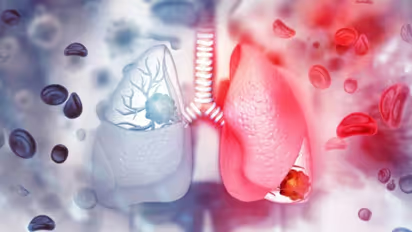Lung Disease: Here are some warning signs one needs to check out

Synopsis
Early warning signals of lung disorders are critical for prompt intervention and successful care. Understanding these indications allows people to seek medical care early, averting severe repercussions.
Lung diseases can manifest subtly at first, making awareness of early warning signs crucial for timely intervention and effective management. Understanding these signs empowers individuals to seek timely medical advice, potentially preventing advanced complications. Because lung illnesses might first present themselves in a subtle manner, it is essential to be aware of the early warning signals to ensure prompt intervention and appropriate therapy. When individuals are aware of these symptoms, they are better able to seek medical care at the appropriate time, which may help them avoid more serious issues.
Early Signs of Lung Disease:
Persistent Cough: A lingering cough that lasts over a few weeks, especially if it produces mucus or blood, warrants attention. It may indicate conditions such as chronic bronchitis, pneumonia, tuberculosis, or even lung cancer.
Shortness of Breath: Difficulty breathing, particularly during routine activities, could signify underlying lung issues like asthma, chronic obstructive pulmonary disease (COPD), pulmonary fibrosis, or pulmonary hypertension.
Wheezing and Chest Tightness: Wheezing—a high-pitched whistling sound when breathing—and a feeling of tightness in the chest may indicate narrowed airways seen in asthma or COPD.
Fatigue and Weakness: Feeling unusually tired or weak despite adequate rest may point to reduced oxygen flow due to lung function impairment seen in conditions such as COPD, pulmonary fibrosis, or lung cancer.
Unexplained Weight Loss: Sudden weight loss without changes in diet or exercise could be a sign of various lung diseases, including lung cancer, tuberculosis, or pulmonary fibrosis.
Also Read: 6 types of rest everyone needs for their well-being
Advanced Signs of Lung Failure:
Severe Shortness of Breath: Rapid or severe onset of breathlessness, even at rest, is a critical symptom requiring immediate medical attention. It could indicate acute conditions such as acute respiratory distress syndrome (ARDS) or exacerbations of COPD.
Chronic Cough with Blood: A persistent cough accompanied by blood (hemoptysis) could indicate serious conditions such as tuberculosis, lung cancer, or bronchiectasis.
Cyanosis: Bluish tint on lips or fingertips due to lack of oxygen in the blood—a sign of advanced lung disease seen in conditions like ARDS, COPD, or pulmonary embolism.
When to Consult a Pulmonologist:
Early consultation with a pulmonologist is advised if you experience any of the above symptoms persistently. A pulmonologist specializes in diagnosing and treating lung conditions, offering expertise in:
Diagnostic Tests: Pulmonary function tests, imaging studies (like X-rays or CT scans), and blood tests help identify the underlying cause.
Also Read: Goa to Shillong: 7 best places to visit in India during monsoons
Treatment Options: From medication to pulmonary rehabilitation and surgery, pulmonologists provide comprehensive care tailored to individual needs.
Lifestyle Modifications: Guidance on smoking cessation, proper nutrition, and exercise to improve lung health and overall well-being.
In conclusion, recognizing warning signs of lung disease early can significantly impact treatment outcomes and quality of life. If you or a loved one experience persistent respiratory symptoms, seek medical advice promptly to ensure timely intervention and effective management.
-By Dr Shubham Sharma, Consultant Interventional Pulmonologist, Gleneagles BGS Hospital, Bengaluru
Explore the latest Lifestyle News covering fashion, wellness, travel, Food and Recipes, and more. Stay updated with trending Health News, fitness tips, and expert insights to inspire your daily living. Discover personalized lifestyle trends that keep you stylish and informed. Download the Asianet News Official App from the Android Play Store and iPhone App Store for everything that adds value to your everyday life.